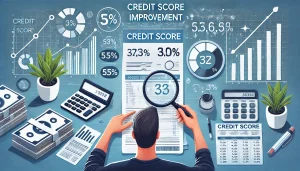The importance of credit in the United States cannot be overstated; it serves as a crucial pillar in the financial architecture. Credit score, a key component, directly influences one’s ability to secure loans, qualify for mortgages, and even rent apartments. Understanding how this score interacts with debt is essential for maintaining financial health.
Anúncios
While many are aware of their credit scores, few understand the full scope of its implications. Credit scores often dictate the interest rates one pays and are critical in times of financial decision-making. Therefore, implementing robust strategies to improve this numerical representation is not just beneficial—it’s necessary.
How does credit score work and its relationship with debts

The most commonly used credit score systems in the U.S. are the FICO Score and VantageScore. These scoring models consider several factors, such as payment history, credit utilization, credit age, new credit inquiries, and credit mix. Each plays a role in determining the overall score. Understanding these factors is essential in arranging financial priorities.
High levels of debt can devastatingly impact your credit score. Major credit scoring models perceive high credit utilization as risky behavior. This is because the more your credit balances are nearing their limits, the riskier you appear to lenders.
Moreover, proactively managing these elements can alleviate the financial burden and nurture a stable credit score. With the right strategies in place, debt can be managed more effectively, negating potential damage to your financial standing.
FICO vs. Vantage Score: Understanding the differences
Both FICO and Vantage Score serve the same purpose but have subtle differences in their methodologies. FICO, for example, heavily weights payment history and amounts owed. In contrast, VantageScore considers recent financial behavior more significantly. Familiarity with these differences can guide individuals in tailoring their financial management approaches.
Understanding how each score functions can offer insights into areas that need improvement. For instance, if your VantageScore is lower due to recent delinquencies, focusing on timely payments can offer rapid improvements. By mastering these specifics, consumers can take control of their financial narratives with confidence.
Impact of debt on your score
Debt impacts credit scores in multiple ways—primarily through utilization rates and payment histories. Maxed-out credit lines present a red flag to lenders, indicating financial distress. Hence, managing the percentage of available credit you’re using is crucial for keeping scores high.
On-time payments not only prevent score degradation but also contribute positively to credit histories. Making timely payments showcases reliability, reducing risk from the lender’s perspective. Thus, habitual punctuality in meeting financial obligations creates a solid foundation for credit improvement.
Strategies for efficiently reducing debts
Implementing effective debt reduction strategies is vital for improving credit ratings. The Snowball and Avalanche methods provide structured approaches—Snowball emphasizes paying smaller debts first, while Avalanche focuses on high-interest debts for swift relief.
Debt consolidation is another viable strategy, potentially lowering monthly payments and simplifying finances. While consolidation offers benefits, understanding when to utilize loans to pay off credit card debt is key to avoiding further financial strain. Informed decision-making is essential for maximizing the efficacy of these strategies.
Debt negotiation: A path to financial relief
Negotiating with creditors can lead to significant reductions in interest rates or even settlements. Engaging proactively with creditors to renegotiate terms often results in more favorable repayment agreements.
Clear communication and a strategic approach are paramount when pursuing negotiations. Preparing a solid argument highlighting your commitment can pave the way for successful negotiations. Hence, approaching creditors with confidence and preparedness can lead to mutually beneficial arrangements.
Choosing the right strategy: Snowball vs. Avalanche
The choice between Snowball and Avalanche methods depends on personal preferences and financial goals. Snowball, with its focus on quick wins, helps build momentum through early successes, enhancing motivation.
Conversely, the Avalanche method targets long-term savings by addressing high-interest debts first. It is ideal for individuals motivated by minimizing the total cost of debt. Each technique presents specific benefits.
Common errors that damage your credit score
Avoiding certain pitfalls can prevent credit score damage. Closing old accounts reduces the average account age, which may negatively impact your credit history. Keeping accounts active, even if unused, can favor your credit length positively.
Simultaneously opening many accounts can raise red flags by generating multiple inquiries over a short period, suggesting financial distress. Deliberate and strategic account opening is advisable to mitigate negative influence.
Identifying errors on credit reports
Examining credit reports regularly is fundamental in detecting inaccuracies. Mistakes such as incorrect balances, misattributed accounts, or erroneous late payments can lower credit scores.Taking prompt actions like disputing identified errors is crucial.
Disputes resolved by credit bureaus can restore and even improve credit standing. Awareness of these errors fortifies financial credibility. Regular monitoring ensures accuracy, empowering individuals to address discrepancies rapidly. Keeping reports error-free reflects a robust credit profile to potential lenders.
Preventing credit score decline
Preventative measures safeguard against inadvertent score decline. Timely payments, moderate credit usage, and minimizing new inquiries uphold the credit standard. Strategizing financial decisions prior to execution preempts unforeseen repercussions.
Decision-making grounded in foresight preserves the integrity of one’s credit profile. By integrating these practices, consumers can better manage their credit scores. Such diligence reinforces sustainable financial practices and supports continuous credit improvement.






